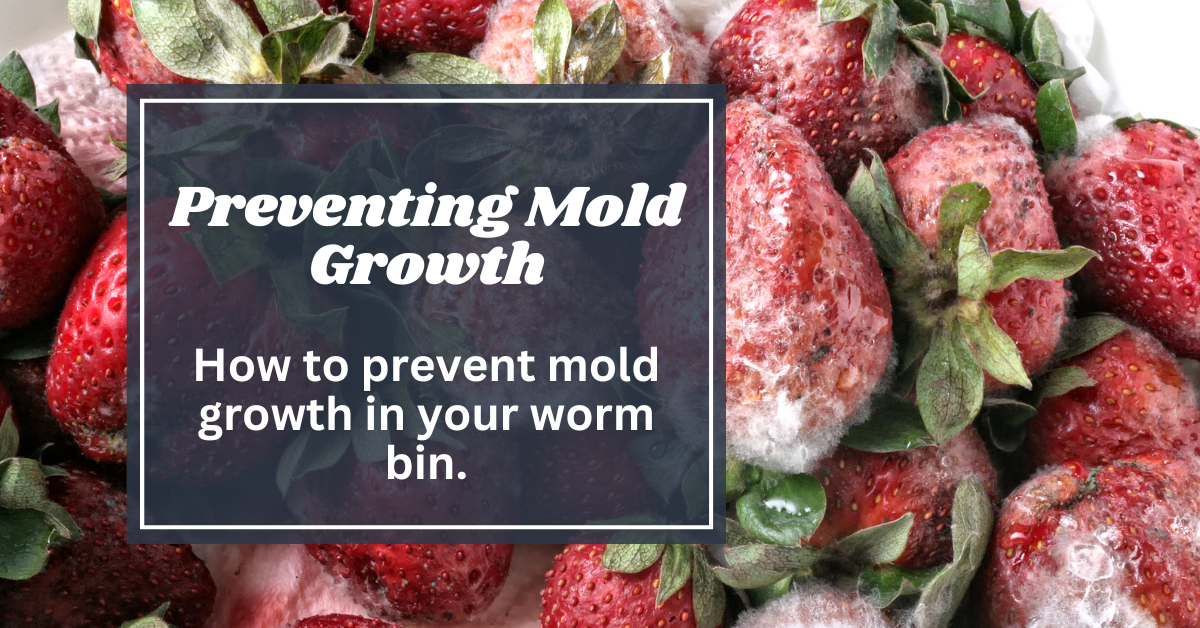How to Prevent Excessive Mold Growth in Your Worm Bin
Please note that this post may contain affiliate links, which means we may earn a commission if you make a purchase through our links, at no extra cost to you. Learn more.
Greeted by some white fuzzy stuff when you went to check on your worms? Don’t panic! While mold is a common (and often harmless) co-inhibitor of your worm bin, there are some steps to take if you’re worried things are getting out of hand.
Mold growth is a common issue in vermicomposting bins, especially for those just starting out with vermicomposting. While a little mold is normal and can even aid in breaking down food, excessive mold growth can signal a problem with the bin’s balance and may affect the health of your worms.
In this post, we’ll explore what causes mold in worm bins, how much is too much, and practical steps you can take to prevent mold from taking over your bin.
What Causes Mold in a Worm Bin?
Mold thrives in environments where there is excess moisture and an abundance of organic matter. Which, probably sounds like the exact conditions of your average worm bin, right?
Here are some of the main factors that contribute to mold growth in indoor worm bins:
- Excess Moisture: Worm bins need to be moist, but too much water can create an ideal environment for mold. Over-watering the bin or adding too many wet food scraps can lead to a soggy, mold-friendly situation.
- Improper Food Breakdown: When food scraps, particularly fruit and bread, don’t break down quickly enough, they tend to grow mold. This is more likely to happen if you’re adding too much food for your worms to process.
- Lack of Aeration: Worms need oxygen to thrive, and so does the composting process. A poorly ventilated bin can cause pockets of stagnant air, which encourages mold growth. Without enough airflow, food won’t break down properly and mold will start to flourish.
Understanding these factors is the first step toward preventing mold in your bin. Let’s move on to see how it can impact your worms.
Is Mold Dangerous for Worms?
The presence of mold in your worm bin isn’t necessarily a bad thing. In fact, mold helps break down organic matter, which can make it easier for worms to process. However, excessive mold growth can be problematic for a couple of reasons:
- Competition for Food: Mold and worms both feed on decaying organic material. When there’s too much mold, it can outcompete the worms for food, slowing down the vermicomposting process.
- Potential for Bin Imbalance: Large amounts of mold can indicate an imbalance in your bin’s environment. This could lead to other issues, such as an unpleasant smell, a decrease in worm activity, or even the development of anaerobic conditions, which can harm your worms.
While some mold is natural and not harmful, keeping it under control is key to maintaining a healthy, balanced worm bin.
How to Manage Mold in Your Worm Bin
If mold is starting to take over your worm bin, don’t worry — there are several steps you can take to control it and maintain a healthy environment for your worms:
- Add More Bedding: If your bin is too moist, adding dry bedding such as shredded newspaper, cardboard, or coconut coir can help absorb the excess moisture. This will create a better balance and discourage mold growth.
- Reduce Moisture: If overwatering is an issue, scale back (or stop!) if you’re adding water to the bin. Check the moisture level regularly — the bedding should feel like a wrung-out sponge, not soggy or dripping.
- Feed Smaller Amounts: Overfeeding can lead to uneaten food sitting in the bin for too long, which promotes mold growth. Try adding smaller amounts of food scraps at a time to ensure your worms can keep up with the decomposition process.
- Bury Food Scraps: Burying food scraps under the bedding helps reduce the surface area where mold can form. It also allows the worms to access the food more efficiently and minimizes exposure to air, where mold spores thrive.
- Increase Ventilation: Make sure your bin has adequate airflow. You can add more ventilation holes or gently stir the bedding to improve aeration. Worms thrive in well-oxygenated environments, which also helps prevent mold.
Managing moisture and feeding habits effectively will go a long way toward controlling mold and maintaining a healthy worm bin.
Key Takeaways
- Mold is natural: A small amount of mold is normal and helps break down food in your worm bin, but excessive mold growth can signal imbalances.
- Maintain moisture levels: Keeping your bin at the right moisture level is key to preventing mold overgrowth. Your bedding should feel like a wrung-out sponge.
- Manage feeding habits: Feed your worms smaller amounts more frequently and bury food scraps under bedding to limit mold exposure.
- Improve ventilation: Ensuring proper airflow helps keep the environment oxygenated, discouraging mold growth and keeping your worms happy.
By maintaining the right balance of moisture, food, and ventilation, you can keep mold under control and ensure your worms stay healthy.









